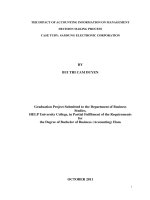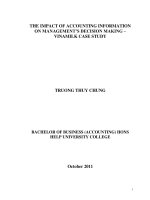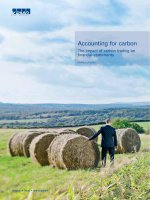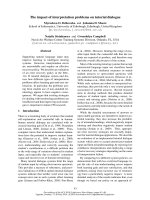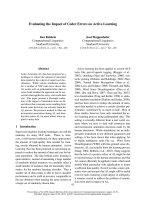the impact of accounting information on management’s decision making vinamilk case study
Bạn đang xem bản rút gọn của tài liệu. Xem và tải ngay bản đầy đủ của tài liệu tại đây (734.53 KB, 56 trang )
i
THE IMPACT OF ACCOUNTING INFORMATION
ON MANAGEMENT’S DECISION MAKING –
VINAMILK CASE STUDY
TRUONG THUY CHUNG
BACHELOR OF BUSINESS (ACCOUNTING) HONS
HELP UNIVERSITY COLLEGE
October 2011
ii
THE IMPACT OF ACCOUNTING INFORMATION ON MANAGEMENT’S
DECISION MAKING – VINAMILK CASE STUDY
By
TRUONG THUY CHUNG
Graduation Project Submitted to the Department of Business Studies,
HELP University College, in Partial Fulfilment of the Requirements for
the Degree of Bachelor of Business (accounting) Hons
OCTOBER 2011
iii
DECLARATION
I hereby declare that the graduation project is based on my original work except for
quotations and citations which have been duly acknowledged. I also declare that it has
not been previously or concurrently submitted for any other course/degree at HELP
University College or other institutions. The word count is 10,036 words.
_____________________
TRUONG THUY CHUNG
Date: 17 October 2011
iv
ACKNOWLEDGEMENT
First and foremost, my sincere gratitude is dedicated to my supervisor – Ms Nguyen Van
Anh. Thanks for your strong support, guidance, intuitive comments and also motivation
through the process of completing this thesis.
In addition, I would like to send my gratitude to the International School and HELP for
giving me an opportunity to conduct my study in my favorite area.
Thanks to all my family and friends for your supports, helps and motivation and made it
possible for me to complete this study
v
THE IMPACT OF ACCOUNTING INFORMATION ON MANAGEMENT’S
DECISION MAKING – VINAMILK CASE STUDY
By
TRUONG THUY CHUNG
October 2011
Supervisor: Ms. Nguyen Van Anh
This thesis “The impact of accounting information on management’s decision making –
Vinamilk case study” is conducted to provide some purpose tools and select the
appropriate information for decision making of the Vinamilk Company. This study also
emphasizes on the important of accounting information in making decision. In addition,
accounting tools such as cost accounting system, price and competition and profitability
provide the useful information manager to make the financial and economic decision as
well. The core method to implement the research is qualitative research. The data is
collected in secondary sources and case study.
vi
TABLE OF CONTENTS
Page
Declaration i
Acknowledgement ii
Abstract iii
Table of contents iv
Chapter 1: Introduction … 1
1.2 Back ground…………………………………………………………… 1
1.3 Problem statements………………………………………………………2
1.3 Structure of paper……………………………………………………… 4
Chapter 2: Literature review……………………………………………… 6
2.1 Decision making process…………………………………………………6
2.1.1 Planning process……………………………………………………… 8
2.1.2 Control process…………………………………………………………9
2.1.3 Limitations of Drury model……………………………………………9
2.1.4 Long term and short term decisions………………………………….10
2.2 Management accounting and decision making……………………… 10
2.3 Defining the cost terms………………………………………………….11
2.4 Tools for decision making……………………………………………….12
2.4.1 Cost accounting system……………………………………………… 12
2.4.2 Price and competition………………………………………………… 14
2.4.3 Profitability…………………………………………………………… 15
2.4.4 Financial ratio………………………………………………………….16.
vii
Chapter 3: Methodology…………………………………………………….19
3.1 Qualitative research…………………………………………………… 19
3.2 Case study……………………………………………………………… 20
3.3 Data resources………………………………………………………… 20
Chapter 4: Analysis…………………………………………………………23
4.1 Company presentation………………………………………………… 23
4.1.1 Vision, mission and objectives……………………………………… 24
4.1.2 History…………………………………………………………………25
4.1.3 Organization and management structure………………………… 26
4.2 Analysis case study…………………………………………………… 27
4.2.1 Accounting tools are used in Vinamilk………………………………27
4.2.1.1 Cost accounting system…………………………………………… 28
4.2.1.2 Pricing and competition…………………………………………….32
4.2.1.3 Profitability………………………………………………………….37
4.2.1.4 Financial ratio……………………………………………………….40
Chapter 5: Conclusion………………………………………………………46
5.1 Summary…………………………………………………………………46
5.2 Recommendation……………………………………………………… 47
5.3 Limitation and further research……………………………………… 47
Reference…………………………………………………………………… 49
1
Chapter 1: Introduction
1.1 Back ground
The Vietnam Dairy Products Joint Stock Company (Vinamilk) was established in 1976
and it has grown to become the leading corporation of the dairy industry, currently has
75% market share of milk in Vietnam. Vinamilk always provides with the quality
products, most nutritious and delicious for health. Vinamilk always satisfies and be
responsible for customers by diversifying products and services, quality assurance, food
hygiene and safety with competitive prices, business ethics of respect and obey the law.
In generally, management accounting usually provided the decision-making functions to
the managers. It involves functions through from planning, organizing
to test the evaluation stage. The function of decision is applied continuously during
operation of the business. The decision making process is the choice of many different
alternatives. In which each option is considered including accounting information,
particularly information on the investment costs to achieve optimal business benefit.
Each action plan is a different situation, with the type, amount, expense items and other
investment income. But they only have one thing in common that are associated with
accounting information. Therefore, the management is required to consider carefully
making a right decision. However, in order to make a right decision, the management
should have the tools to help them distinguish the proper accounting information relating
to each plan. Based on this, the plan chosen will give the highest profit or lowest cost.
In recent year, there are many companies which have gone to bankruptcy because of the
mismanagement. So today, the management is required to train more with experienced
and professional’s skills. Moreover, the management is also able to see right things to
2
make decisions and choose the plan that set out on the basis of selecting the appropriate
information.
This thesis “The impact of accounting information on management’s decision making –
Vinamilk case study” is conducted to provide some purpose tools and select the
appropriate information for decision making of the Vinamilk Company. Besides, the
necessary of this thesis not only serve for the commercial organizations but also non
commercial organizations which need the accounting information to survival and
development. The commercial organizations such as private companies, joint venture,
and limited companies need the accounting information to determine the production and
business efficiency in the period. While non-commercial organizations such as clubs,
associations with the main objective is social activity, charitable activities which need
accounting information to determine the level of service. And State institutions also need
accounting information to assess the provision of security and social services.
To sum up, accounting information is a key factor which plays an important role over
the activities of an organization and impact on decisions to achieve the level of the target
set.
1.2 Problem statements:
Which are accounting tools available used to support decision making process?
Accounting tools play a vital role in business decision making process. Management
accounting consists of a set of tools that have been proven to be useful in making
decisions involving cost data, price and profit. The costing system provides to the
obtainable knowledge of costs, and it builds the basis for numerous decisions like as
determining prices, estimating the profit. Profitability is used especially for making
decisions relating to suspended operations of organization. Nowadays, accounting tools
3
apply differ from organization. A tool that proves to be very effective in an organization,
however, it may fail in another organization. Different information is required for
different purposes, so the organization must focus on the different accounting tools to
support the decision making process.
Which accounting tools are applied in Vinamilk? How does the company use
those in the decision making process?
As mentioned above, Vinamilk uses an old way of classifying costs, which considers all
administration and selling cost as fixed costs and all production costs as variable
although within the production costs there would be fixed costs, like depreciation. Thus
labor costs of the production are also seen as variable. In addition, Vinamilk produces a
lot of vary products and buys the ingredients such as milk from outside supplier. Milk
imported nowadays accounts 70% raw materials of Vinamilk. Hence, the manager has to
evaluate and calculate the cost in the future due to the management cannot consider the
price of materials in the future. Furthermore, Vinamilk manages indirect cost and
overhead cost, selling costs and administrative costs as well. Base on costing system,
manager should determine the price. Vinamilk uses both of cost plus pricing and target
costing such as it decides first how much it costs and then its department works together
with the production to stay within this cost structure. Prices of competitors and their
reaction also effect on prices for the valuation of the company. Consumers assess the
value and price of a product based on price and value of similar products. A strategy of
high prices, high profitability levels, may attract competition, while a strategy of low
cost, low-can discourage the competition or do they withdraw from the market.
Companies need to know price and quality of the opponent. This can be done in several
ways. Companies can send personnel to study and compare the prices of the competing
4
products. Companies can search by price of competitors, looking to buy their equipment
and analysis. The company may ask the buyer to see how they feel about the price and
quality of competitors. Another tool often used in Vinamilk is profitability, which is
defined as the price customers paid minus the cost of production. In Vinamilk, they split
up the products in different groups of product and they also distinguish the cost of the
machine for each product. Hence, they can calculate the gross profit for each product
group every month. By this system, Vinamilk knows which products are profitable. In
order to attaining a better profit, the managements also made the most difficult decision
in his career. Vinamilk maintains high profit margins; this suggests that the ability to
manage costs and price of company is very good.
Furthermore, besides information of managerial accounting provided, the managers
should consider the financial information such as financial ratio in order to understand
the business activities of company.
1.2 Structure of paper
The paper is conducted to find out the accounting tools which are applied in Vinamilk
and how these tools affect to the decision made by the company. This paper contains five
chapters as follow:
Chapter 1: Introduction
Chapter 2: Literature review
Chapter 3: Methodology
Chapter 4: Analysis
Chapter 5: Conclusion
In the chapter 1, the information of Vinamilk and the importance of this thesis are
introduced. In chapter 2 and chapter 3, the basic theory which includes the ideas of
5
different accounting tools and steps for decision making is recommended. The
methodology will provide the process of how this study is conducted. After collecting
data and information, the analyzing process would be implemented in chapter 4. Finally,
the chapter 5 will draw the conclusion as well limitation and recommendation.
6
Chapter 2: Literature review
Nowadays, financial information and non financial information provided by
management accounting can help managers in making decisions as well. In order to
clarify the relationship between management accounting and decision-making, the both
of concepts will be proved independently in the following.
2.1 Decision making process
Before explain the concept decision making process, the decision should be determined.
A decision is a choice leading to a certain desired objective (Holsapple, pp. 35 – 36).
A person or other different participants that are included in decision-making can be
called decision makers. Individual decisions can be made by a computer or a
single person while the various decision makers can be divided into independent and
negotiated decisions. The first one is that the single person who has the power to decide
and the other people can greatly influence how the decision will be. In negotiated
decisions, the different decision makers will share the right of making a decision. That
means the people have practically equal rights and discuss their different ideas in various
meeting and organization decisions. The second one is that the right of making a
decision is unequally shared due to the organizations hierarchy and the management
between the decision participants is highly structured.
Table 1 will give more information about the types of decision makers:
7
Distinguishing
traits
Individual
Team
Group
Organization
Participants
One
Multiple
Multiple
Multiple
Authority
Vested in one
person
Vested in one
person
(deciding
participant)
More or less
equally shared
by all
participants
Can be
distributed
unequally
among
participants
Formal
communication
among
participations
None
Relatively
structured
Relatively few
restrictions
Can be quite
structured
Table 2.1: adapted from Holsapple, C.W., Whinston, A.B. (1996) p. 69
Making decision is the one of main functions of the managers. The management often
faces some decisions such as what to produce? How to produce? How to distribution? In
order to successful in making decision, the managers need have relevant information in
some circumstances.
There are many types and context of decision and the outcome of decision often depend
on the decision maker. In some model of decision making process, every decision has to
follow some common steps. These steps can be applied for decision making process
usefully (Holsapple , p.71).
Figure 1 indicates the diagram of decision making process. There are seven stages in
Drury’s model. The first five stages show the planning or decision making process. It is
8
described as making choices between options and it is mainly decision making activity.
The final two stages present the control process that should measure and correct the
detailed performance of the alternatives chosen. (Drury, p.6-9)
Figure 2.1: Adapted from Drury C. (2000), p. 6
2.1.1 Planning process
1. Identify objectives: This is a first step of planning process; the managements need to
identify the specific of the goals or objectives of organizations. They will give to
decision makers some guidance or directions and enable decision makers to estimate the
action desirability compared to another action. In economic, maximizing profitability of
company’s owners and shareholders wealth should be a main objective.
2. Search for alternative courses of action: This is not only the most important but
also difficult step in the decision-making process. The management has to look for
alternative ways of action that enable goals to be achieved. Thus the organization has to
look at its environment for challenges and opportunities.
3. Gather data about alternatives: The managers should access the potential growth rate
of activities, potential areas of company in order to gain market share and cash flow.
9
Furthermore, the decision makers have to differentiate between certainty, uncertainty
problem that are difficult to control such as inflation, competitions strength etc. Data and
information are gathered by both short term and long term decision.
4. Select alternative courses of action: The decision making includes the choosing
between competing alternative courses of action and best satisfies objectives of the
company. For example, if the profit maximization is main objective, all options should
be planned in terms on differences in profit. The option that seems to achieve the goal
best then it should be selected by the decision makers.
5. Implement the decision: This is final steps of planning process. After choosing the
best alternatives, the decision would be conducted through the planning process. The
management has to consider carefully and communicates with other people in the
organization who work closely together before to implementation decision.
2.1.2 Control process
6. Compare actual and planed outcomes: This is the first stage of control process. The
managers should compare actual implementation and budgeting, and then determine
what the difference is. An accountant has to set up presentation reports which provide
feedback by comparing results with plans.
7. Respond to divergences from plan: After the alternatives chosen should be frequently
checked and if the results of the decisions made differ from the designed one, corrective
actions should be taken.
2.1.3 Limitations of Drury model
There are several reasons criticized Drury model. Firstly, the right decisions are easily
and clearly identifiable. Secondly, it does not include factors, like emotions,
imagination, memories, culture and mindset of the decision-makers. Finally, it is built on
10
the idea that each step can be clearly separated from the other that does not correspond
to the reality of decision making. (Langley, pp.261-264)
2.1.4 Long term and short term decisions
The decision can classify into long term and short term decisions. Long term decision
refers to the decision that impacts on the longer periods of time (Ibid. p. 8). In
organization, long term decision may be a capital investment such as buying machinery,
building factory and so on. On the other hand, short term decision is the decision that
affect on one year or less than one year (Ibid. p. 233). This decision is based on currently
data and be easily to changes. The one of example of short term decision is determining
of acceptation or rejection order.
2.2 Management accounting and decision making
According to investorwords.com, accounting is defined as the systematic recording,
reporting and analyzing of financial transactions of a business. There are two types of
accounting which are management accounting and financial accounting. In this project,
management accounting would be focused. Management accounting refers to the
process of preparing management reports and accounts that provide accurate and timely
financial and statistical information required by managers to make day to day and short
term decisions (www.businessdictionary.com).
The management accounting information plays a vital role in decision making of the
managers. Accounting can be viewed as the process of identifying; measuring and
communicating economic information to permit informed and predicted decisions for
the user of information. (Horngren pp.18.182). This means that understanding clearly of
accounting information will help the management to give out better decisions for the
organization. Management accounting is a division of information systems of an
11
organization. Managers rely on accounting information for management planning and
control activities of the organization (Hilton, 1991). Therefore, the reported and
collected accounting information can influence on making management’s decision and it
will result in the management to make decisions that are consistent with the
organization’s goals. Moreover, the decision maker often decides what information is
inputted and considers information as relevant for the decision. Using accounting
information depends on different decisions and it often relies on the choices of decision
maker whose may be affected by experience, perceptions and objectives. Apparently,
accounting information is used for decision-making rises if the information provided is
relevant for the decision, and again. The increasing decision making is also relies on the
decision maker who regards the accounting information as reliable and trustiness.
2.3 Defining the cost terms:
1. A cost is known as the resources are in place to complete a special reason. It is very
common to determine the amount the cost of money to obtain goods and services.
(Horgngren, p. 133)
2. A cost object is looked as a cost of products and as well as costs of a department or
service. (Drury, p. 21)
3. Fixed cost and variable cost: Fixed cost refers to the cost that does not increase or
decrease when level of activities decrease or increase. So the cost per unit will decrease
when the level of activities increase and again. On the other hand, variable cost is the
increasing or decreasing cost when the activities increase or decrease. But for per unit,
the level of activity is constant cost, and it will disappear when stop working. (Ibid., pp.
29 – 30)
12
4. Direct cost and indirect cost: Direct cost is known as the cost that is easily and
conveniently monitored to the particular cost object under consideration. Meanwhile,
indirect cost is known as all the other costs that cannot be related to or identified with, a
particular cost object under consideration. (www.accountingformanager.com)
5. Relevant and irrelevant cost: Relevant costs are those costs that can be affected by
decisions whereas irrelevant costs cannot be affected through a certain decision. It
may be irrelevant for some situations, but relevant for others. Examples of irrelevant
costs involve fixed overheads, notional costs, sunk costs and book values
(www.businessknowledgesource.com).
2.4 Tools for decision making
In order to make a better decision by using accounting information, management has to
rely on the tools of accounting system. There are many tools of accounting, but in this
thesis, three accounting tools are discussed. Firstly, the cost accounting system
determines the costs that are accounted in goods produced of company. Hence,
management needs to understanding about the information of costs that occur in an
organization. This tool is considered as the most important tool in guiding decision.
Because the management would be able to set prices and estimate profit based on
information about costs. Secondly, pricing and competition tool would be discussed It
involves the ideas of target costing and cost plus pricing, competition. Finally,
profitability tool would be recommended.
2.4.1 Cost accounting system
Cost accounting refers to a part of accounting that evaluates the overall costs associated
with conducting business. The main aim of cost accounting is basically providing
product costing information for financial statements, control, and decision making
13
(www.wisegeek.com). A cost accounting system includes two steps, the cost gathering
by classifying costs into categories and the assignment of costs to cost objects.
The first one refers to the collection of costs by using classification criteria, like
the relevance of costs or the cost behavior. Different types of costs are available for
different decisions. Hence, as first step is useful for decision-making to sort out costs as
fixed or variable, relevant or irrelevant and direct or indirect. For example, when the
management wants to make-or-buy machinery, decisions will concentrate on relevant
costs in a particular decision situation. The second one is cost allocation related to
indirect costs that are allocated to a cost object. It is related to methods of classifying the
direct and indirect cost, and determining which is important for cost accounting system.
In generally, there are two main methods of allocating indirect cost: traditional
accounting system and activity based costing (ABC). The first one refers to the
allocation of factory’s indirect cost to product manufactured. That means traditional
accounting system allocates the indirect cost to cost centers. It is rely extensively on the
volume based allocation such as the direct labor hours, number of units produced, or
machine hours. For example direct labor hours are used as a basis to allocate
costs of materials to a cost object (Drury, p 52-53). Otherwise, the second one refers to
assign the costs to activity cost centers. Activity based costing system is based on cause
and effect allocations. By identifying the costs driver that cause the cost to changes and
assigning the costs to cost objects on the basis of cost driver usage, so the cost can be
more accurately traced (Drury, p 221). The major difference between two methods is
collecting of the cost driver. Traditional costing system relies on arbitrary allocation
while activity based costing is based on cause and effect allocation. The traditional
costing system will be applied when the production process is very simple and clearly,
14
On the other hand, activity based costing will be used when the process of production is
more complicated and used more cost driver. However, using activity based costing will
be more expense and low benefit.
Figure 2.2: Traditional costing vs. Activity based costing (source from internet)
2.4.2 Price and competition
A price is expressed in the currencies of commodity value or in other words is the
number of money pay for goods. Price is also considered an important competitive
factor in attracting customers of all businesses. Pricing decisions can categorize into
short term and long term decision. The first one refers to the price made for the day to
day decision or in short time decision. Otherwise, the second one is that the price would
be determined for the long time of products. Pricing decisions making are one of the
most important decisions that the management have to face (Horngren). The results of
the making pricing decision for new products or responds to price of competition are
15
very important because if a company wants to be survival and develop in the future, it
has to have a reasonable price policy. The price decision has to not only affect to the
market demand but also attain the company’s objectives. There are some factors that
affect to pricing decisions such as legal requirements, competitors actions and customer
demands. There are two common tools for pricing: target costing and cost-plus pricing.
The target costing is known as an effective tool to keep the customer value while
reducing costs. Before products are designed, the target costs are established based on
estimated selling price of the product and the company's profits. Meanwhile, cost plus
pricing refers to the adding an amount or a percentage of the cost of production and
product distribution. This is tools for the company to make the maximized profit.
Competition is way to use other word for company rivals producing similar products or
services. Companies usually use resources effectively, business opportunities to win
other companies in order to ensure the development of business. There are many
methods of competition: price competition (lower prices ) or non-price competition
(advertising ) or competitiveness of a business, an industry, a country is the level at
which, under conditions of free market and fair can produce commodity products and
services to meet the demands of the market and creating jobs and raising real incomes
respectively. Competition is the gain of market share. The nature of competition is the
search for profit which is higher than average profits of enterprises. The outcome of the
competitive process is the average profitability of the industry which trend to effect in
depth, then lead to the price may be reduced (Michael Porter, 1980)
2.4.3 Profitability
Profitability is defined by the ability to make a profit meanwhile profit can be defined as
the difference between total revenue and total cost. Planning of profit is often conducted
16
during the budgeting process. Profitability will be achieved when the right decision was
made by the management and cost control is also good. There are some accounting tools
related to profitability are:
Gross profit is defined as the difference between net sales and cost of good sold
(Horngren C. et al. (2002), p. 59).
Operating profit is known as is the difference between total revenue and total cost from
production and business activities of enterprises. This profit is created before the
payment of interests and taxes. (Prakash, (1979), p. 2)
Working capital is an index used to measure financial performance as well as financial
capacity of a company in the short-term. Working capital is also assessing the ability to
pay short term debt obligations of companies. (www.investorwords.com)
2.4.4 Financial ratio
Financial ratios are calculated from one or more kind of information from a company's
financial statements. Financial ratios also give a financial analyst and management an
excellent picture of a company's situations and the trends that are developing
(www.finpipe.com). There are some common categories of financial ratio such as:
1. Liquidity ratios
It indicates the entity’s ability to meet its current obligations. There are two common
used liquidity ratios are current ratio and quick ratio.
Current ratio is calculated as current assets divided by current liabilities. It includes all
current assets and current liabilities and is considered acceptable if it is 2 to 1 or better.
Quick ratio is defined as quick assets divided by current liabilities. Quick assets are
defined as cash, accounts receivable, and notes receivable – it is determined by current
assets minus inventory. The quick ratio provides better picture of the entity’s liquidity
17
position if inventory contain obsolete or slow moving items. If the ratio is greater than 1
generally shows that the entity’s liquid asset are sufficient to meet the cash requirement
for paying current liabilities.
2. Capital structure
Debt to equity is calculated by the short term and long term debt divided by the
shareholder’s equity. This ratio provide information on solvency of the entity
3. Operational capability
These ratios indicate how effectively the entity’s assets are managed. Therefore, the
ratios related to account receivable and inventory of company
Receivable turnover is defined as credit sales divided by receivables. The ratio
represents that how many times accounts receivable are turned over during a year.
Inventory turnover provide information on the inventory and is calculated as cost of
good sold divided by average inventory. In this case, the average inventory equals sum
of beginning and ending inventory divided by two. This ratio indicates that the
frequency with which inventory is consumed in a year. The higher ratio is the better
liquidating inventory.
4. Profitability ratio
It indicates the entity’s success or failure for a given period. A number ratios measure
the profitability of an entity, and each ratio should be interpreted by comparison to
industry data.
Gross profit percentage: is generally a good indicator of potential misstatements and is
calculated as gross profit divided by net sales.
Profit margin: the profit margin ratio is calculated as net income of company divided by
net sales. This ratio measures the entity’s profitability after all expenses are considered.
18
The fluctuation in the ratio indicates that misstatements exist in the selling, general or
administration expense.
Return on assets: this ratio shows the return earned on the resources invested by both the
shareholders and the creditors. It is calculated as net income divided by total assets.
Return on equity: the ratio is defined as net income divided by shareholder’s equity
The ratio measures an entity's profitability by illuminating how much profit a company
generates with the money shareholders have invested.


